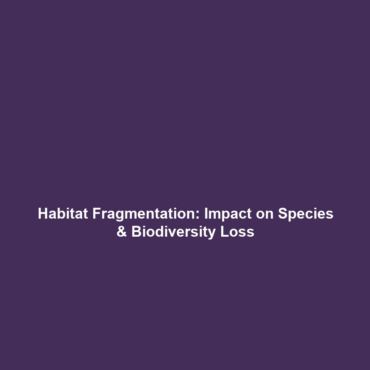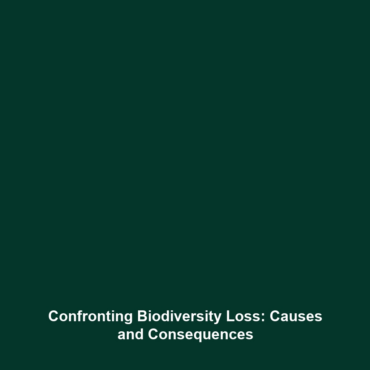Case Studies of Habitat Fragmentation Leading to Species Endangerment
Introduction
Habitat fragmentation is a pressing issue in the context of deforestation and biodiversity loss. This phenomenon refers to the disruption of continuous habitat into smaller, isolated patches, significantly impacting species’ survival. Notably, vulnerable species such as orangutans in Borneo and tigers in India exemplify the dire consequences of habitat fragmentation. Understanding these case studies is essential for conservation efforts and recognizing the interconnectedness of ecosystems. This article delves into pivotal case studies that reveal how habitat fragmentation leads to species endangerment and its broader implications for global biodiversity.
Key Concepts of Habitat Fragmentation
Understanding Habitat Fragmentation
Habitat fragmentation occurs when large, contiguous areas of natural habitat are split into smaller, isolated fragments. This disruption can stem from human activities such as logging, agriculture, and urbanization. Key issues associated with habitat fragmentation include:
- Loss of biodiversity: Isolated populations become more vulnerable to extinction.
- Inbreeding: Limited gene flow can lead to genetic bottlenecks.
- Altered species interactions: Species may find their ecological relationships disrupted.
Case Studies: Orangutans in Borneo and Tigers in India
Two landmark species affected by habitat fragmentation are the orangutans in Borneo and tigers in India, which showcase the dire impacts of deforestation and biodiversity loss:
- Orangutans: Habitat loss due to palm oil plantations significantly reduces their living space, leading to population declines.
- Tigers: The connectivity of their habitats is compromised, increasing human-wildlife conflict and decreasing prey availability.
Applications and Real-World Uses
The importance of studying case studies of habitat fragmentation extends beyond academic interest, as it holds real-world applications in deforestation and biodiversity loss. Key applications include:
- Conservation strategies: Tailored management plans for protected areas can effectively maintain biodiversity.
- Restoration ecology: Reconnecting fragmented habitats can promote species recovery and resilience.
- Legislation: Informing policymakers to implement protective measures for endangered species.
Current Challenges
While the study of habitat fragmentation is critical, several challenges persist:
- Data scarcity: Limited research on certain ecosystems hampers effective conservation efforts.
- Funding constraints: Insufficient resources for implementing habitat restoration initiatives.
- Political resistance: Conflicting interests can hinder the enforcement of conservation policies.
Future Research and Innovations
Future research on habitat fragmentation promises potential breakthroughs that may significantly impact deforestation and biodiversity loss:
- Remote sensing technologies: Enhanced monitoring capabilities can track habitat changes and species movements.
- Community-based conservation: Innovations that engage local communities may foster sustainable practices.
- Genetic studies: Research aimed at understanding genetic diversity can inform breeding programs for endangered species.
Conclusion
Understanding case studies of habitat fragmentation is crucial to addressing the endangerment of species such as orangutans in Borneo and tigers in India. These studies reveal the intricate links between habitat health and biodiversity. To combat deforestation and biodiversity loss, it is vital to prioritize conservation strategies and research funding. Engage in local conservation efforts and explore additional resources to broaden your understanding of this pressing issue. Learn more about conservation strategies here.

